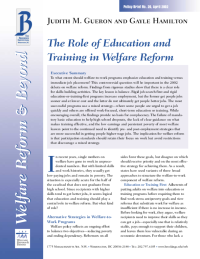The Role of Education and Training in Welfare Reform
To what extent should welfare-to-work programs emphasize education and training versus immediate job placement? This controversial question will be important in the 2002 debate on welfare reform. Findings from rigorous studies show that there is a clear role for skills-building activities. The key lesson is balance. Rigid job-search-first and rigid education-or-training-first programs increase employment, but the former get people jobs sooner and at lower cost and the latter do not ultimately get people better jobs. The most successful programs use a mixed strategy-where some people are urged to get a job quickly and others are offered work-focused, short-term education or training. While encouraging overall, the findings provide no basis for complacency. The failure of mandatory basic education to help high school dropouts, the lack of clear guidance on what makes training effective, and the low earnings and persistent poverty of most welfare leavers point to the continued need to identify pre- and post-employment strategies that are more successful in getting people higher-wage jobs. The implication for welfare reform is that participation standards should retain their focus on work but avoid restrictions that discourage a mixed strategy.
In recent years, single mothers on welfare have gone to work in unprecedented numbers. But with limited skills and work histories, they usually get low-paying jobs and remain in poverty. The situation is especially acute for the half of the caseload that does not graduate from high school. Since recipients with higher skills tend to get better jobs, it seems logical that education and training should play a central role in welfare reform. But what kind of role? This policy brief examines what the best research suggests.







